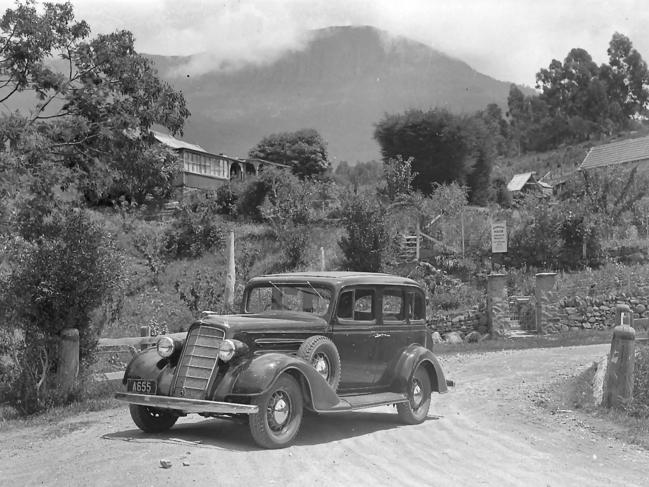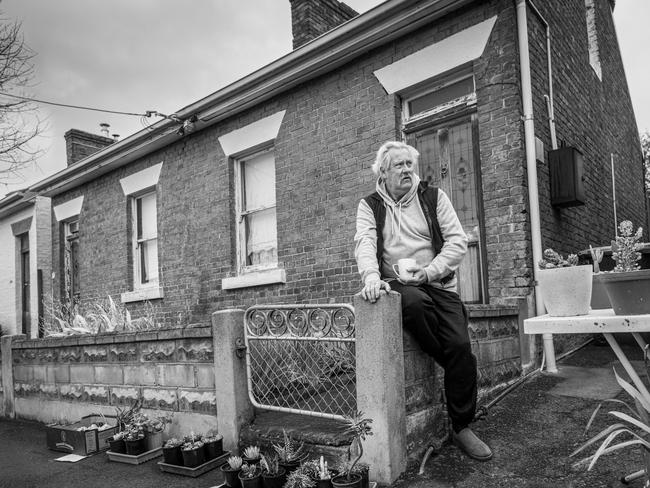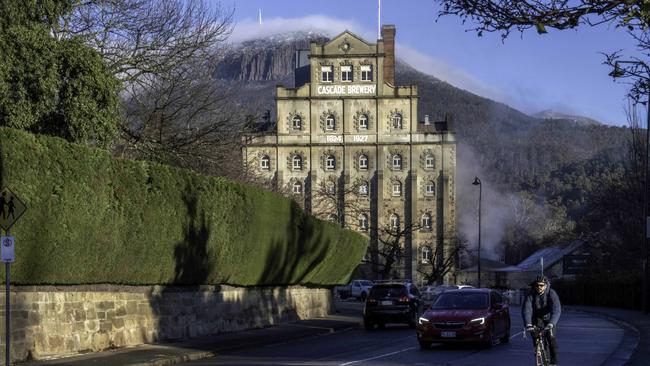Paul County spent his 20s enjoying plenty of overseas adventures – he worked in hospitality in London and Spain, as an English teacher in Bangkok and also spent six months on a farm in Israel growing herbs.
“I was just travelling around with a backpack really, working along the way,’’ he explains.
But when he returned to Tasmania, things didn’t feel quite right.
“I came home, I was about 28, and I fell into a bit of a hole,’’ County says.
“It wasn’t like a serious depression but I thought ‘Am I just going to keep doing this for rest of my life?’ I was working pretty weird hours.’’
He decided he needed a new challenge.


“I loved photography, I had done a few courses over the years through Adult Ed,’’ County explains.
“I decided to apply for art school (at the University of Tasmania), so I did that and I got accepted and majored in photography. I kept working in hospitality and it felt like a really good balance – when I was at art school I felt like I found my home.’’
He then did a teaching degree and applied for his first teaching job at Guilford Young College. And, as luck would have it, they were looking for someone who could teach both photography and catering, which perfectly matched his skill set.
It was during his 14 years in this role that he held an exhibition at the Tasmanian Museum and Art Gallery – called The Raw and The Cooked – which profiled pioneers of Tasmania’s hospitality industry, including personalities such as Claudio Alcorso and George Mure.
And soon after, County found himself publishing his very first book.
“I really wasn’t thinking about doing a book, but people said ‘this would be a great book’ so I thought ‘well, why don’t I do that?’,’’ he says.

He jokes that he “quite famously made every mistake you can make” on that book, as his publishing knowledge was limited.
But he’s since gone on to publish another 16 books – perfecting the art of publishing along the way – including his best known title, Tasmania’s Table: A food lover’s guide to Tasmania’s fine food, drink and restaurants – featuring images by photographer Nick Osborne.
“Tasmania’s Table was Tasmania’s first A4, full-colour, beautifully photographed food book,’’ County says.
“Nick Osborne and I took a bit of a gamble on how it was going to work.
But it sold 10,000 copies, and it just kept selling – we published a second edition because
the first one sold out. And I guess I kind of got addicted (to publishing books).’’
County’s newest book – which is being officially launched on Friday, December 13 – is Discovering SoHo, a celebration of the South Hobart community, which features both words and images by County.

He got the idea for the book four years ago, after he moved from his home in Taroona to live in South Hobart, where his partner, Renata Pasieczny, was already living.
“I moved into South Hobart and I was just walking around,’’ County explains.
“I was on this fitness campaign – which I’m still on – and I would just go walking around the streets of South Hobart. I’m a fairly chatty person, so I’d see someone in their front yard, and I’d say ‘gee, those flowers look nice’, and I’d get chatting.’’
He met so many interesting people, he wanted to compile a collection of the stories.
“There’s something about South Hobart that’s just kind of special,’’ County says.
“It’s one of Tasmania’s first suburbs, there are lots of beautiful old houses, it has got that history. And people are there for a reason – some want to be close to the bush, you’ve got that beautiful rivulet there … you sort of have one foot in the bush wherever you are in South Hobart, you’re influenced by nature and of course you’ve got the mountain as your backdrop and all those walking trails on your doorstep. There’s this really interesting mix today of environmentalists, scientists, people who want to renovate and restore old homes, people who really care about their community, and you’ve also got people who have lived in the same house for 70 years and remember catching a tram up from Hobart.’’

So County approached the South Hobart Progress Association – an organisation which is 100 years old – and pitched the idea of sharing the stories of South Hobart.
The association put out a call in its newsletter, asking residents to nominate themselves, or others, for the book – and received more than 200 nominations. The project has been supported by a Creative Hobart grant from the City of Hobart, and also by Cascade Brewery.
As well as County’s 160-page hardcover book – which took two years to produce and features 46 South Hobart residents – there will be an art trail exhibition, with images and stories from the book being showcased at four South Hobart cafes – Ginger Brown, Bear With Me, SoHo Wholefoods and South Wine Bar.
The idea is that visitors can enjoy the artworks in one day – hopping from one venue to the next – or they can enjoy them slowly, making separate visits to the different eateries, anytime from December 13 until the exhibition ends on February 28.
The portraits and stories are also being shared online, on the South Hobart Progress Association website (southhobart.org.au), with the ongoing project requiring County to capture even more stories in the year ahead, ultimately creating a library of South Hobart residents and their stories.

“It might never end, I might still be doing it when I’m 80,’’ laughs County, who is now 62.
He still teaches part-time – at St Aloysius Catholic College – and loves the mix of teaching and publishing books.
His favourite part of writing Discovering SoHo was not only meeting so many interesting people, but embracing the challenge of how to photograph them in a way that best reflected their unique stories and personalities.
“The best part of it was when I would approach someone,’’ he says.
“I’d say ‘I’d love to come and interview you’ and some were a bit apprehensive, but then I’d meet them and they’d tell me these amazing stories. It’s those surprising stories you get from people that you weren’t ready for – and everybody seemed to have something … a little bit of gold. And then, of course, I’d have to work out from their stories, how am I going to do their portrait. For me, it was more than just writing stories and taking portraits, it was a professional development opportunity, for me to think ‘I’m really going to investigate portraiture and get some studio lights and push it and see how I can develop as a photographer’. All of the portraits are so different because all of the people are so different.’’
Here we meet three characters from Discovering SoHo.
PETER CARPENTER
Peter Carpenter is one of South Hobart’s longest-serving residents – he’s been living in the same house for 70 years.
His parents purchased the two conjoined cottages in Macquarie St in 1947. After returning from active service in World War II, his father worked at Peters Ice Cream in the 50s and 60s, not far from the family home.
“The place is around 170 years old,” Carpenter explains.
“Two ex-convicts named Mure once lived here.’’

County says he was amazed when he was invited inside the home.
“It’s a time warp experience, going back many decades,’’ he says.
“There’s a tiny ladder leading to the upper bedrooms and some rooms still have the original wallpaper. The two cottages are connected by a lean-to at the back.’’
Carpenter estimates that the properties are now worth about $1.4m.
He could easily live in one and rent the other, but says “it wouldn’t be the same, would it?”
He’s opposed to the cable car – “Why would you want to ruin that?” he says of the mountain view from his home – and would like to see better traffic management on Macquarie St with speed reductions, to reduce vibrations from large trucks going to and from the McRobies Gully tip site.
Carpenter has many great memories of growing up in South Hobart.
“I went to Macquarie Street School, then Elizabeth High,’’ he recalls.
“I used to catch the old electric trolley bus home from Franklin Square, then I went into the army like my dad.’’

He enjoys drinking Cascade Pale Ale and remembers after the 1967 bushfires, grown men were crying, because after Cascade Brewery burnt down, they had to drink Boags.
Carpenter is a well-known local figure and he is often seen sitting outside his house meeting locals and selling some of the plants he propagates.
“I love the SoHo village atmosphere,” he says.
“Everybody knows everybody else when you’ve been here a while. I do spend a lot of time out the front chatting – it’s a very laid-back place with a friendly atmosphere. I only go out of SoHo once a fortnight into the city on the bus – I don’t need a car here. And after my city trips, I’m always pleased to get back home.’’
BOB STADDON
Bob Staddon was born in Devon in the UK and trained as an upholsterer in the small Welsh village of Cwmaman. But he came to Tasmania in 1984 on a short trip to visit his wife’s family and decided to stay.
He found a property at the bottom of Wynyard St in South Hobart.

“With its huge garage it seemed ideal for my upholstery business, so I moved in,’’ he says, in his thick Devon accent.
In his workshop there’s always some relaxing 1940s swing and big band music wafting in the background.
Staddon’s property runs right down to the rivulet so there’s also the peaceful sound of flowing water.
From his workspace, Staddon looks out through huge windows onto a neighbour’s house that was once a tannery, one of seven on the rivulet.
“In the early days, tanneries and other industries made the rivulet one of the most polluted waterways in Australia,” Staddon says.
As early as 1824, the Hobart Town Gazette was reporting that many ‘disgusting pollutions’ were being thrown into the rivulet, and people were both bathing and emptying waste in the waterway.

One of the tanneries opposite Staddon's property operated right up until the
mid-1990s. Staddon still has two old sewing machines from the 1940s that he likes to use.
County says stepping inside Staddon’s workshop to photograph him for the book was like stepping back in time.
“When you look through the book, each portrait has something that’s a bit interesting and a bit surprising … they are all different.’’ he says.
Some, like Staddon’s image, are black and white, which County says “makes it feel like it could have been taken 50 or 60 years ago’’.
“His workspace looks cluttered,’’ County says of Staddon.
“But he knows where everything is.’’
KATE CAIRE
The purchase of SoHo Wholefoods in Macquarie St completed a circular journey for Kate Caire, who County describes as “South Hobart’s own Nigella Lawson”.
She grew up in South Hobart and over the years she’s lived in D’Arcy, Wentworth and Washington streets and Cascade Rd.


Caire recalls playing at the Hobart Rivulet, well before the walking track was established.
“I spent my childhood roaming around exploring SoHo and the rivulet,’ she recalls. “It was a great place to grow up. No one worried about us, we could play there all day.’’
Caire says South Hobart has always had good foodie roots.
As a child she loved fish and chips on a Friday night and pizza on Saturday. She also has fond memories of Christmas street parties, where everybody brought their own plate.
Caire has always been involved in hospitality and County describes her as having an infectious sense of humour.
Caire has a local radio cooking spot and runs a cooking school called Carnation Kitchen with her best friend Courtney Bell.
County suggests Caire is “SoHo’s own Nigella Lawson”, a moniker Caire is flattered by.
“She’s my icon,” she says.
Caire is the daughter of pioneering Hobart restaurateur and cookbook author John Caire.

She recalls being propped up on a restaurant kitchen table when she was only four, making curly carrots while her father turned sizzling steaks at the Franklin Grill in the Huon Valley.
“Dad also operated a tea gardens and a pizza shop in Franklin,” she says. “I was destined to work in hospitality. There was really nothing else I wanted to do. I’ve never completed any formal cooking qualifications. I just learnt on the job, working in dozens of Hobart eateries in the 80s and 90s.’’
She describes her father as her mentor.
He came to Hobart as assistant manager at Hadley’s Hotel in 1971 which was owned by Federal Hotels. He then went to the-then new Wrest Point Hotel Casino as conventions and banquet manager in 1973.
He has established and operated some of Hobart’s most iconic restaurants – including JC’s, Astor Grill and The Ball and Chain – and most recently ran Maning Reef Cafe in Sandy Bay (which closed last year), with Kate as manager. John purchased a butcher shop at the top end of Macquarie St and made gourmet sausages in South Hobart in the early 80s.
At age 11, Kate worked on her father’s mushroom stall promoting Huon Valley Mushrooms – the tempura mushrooms were hugely popular at festivals, including The Taste of Tasmania, Festivale and Agfest.

“Dad and I always joke that I’ve had a 30-year cooking apprenticeship without actually getting any papers,” she laughs.
In her father’s honour, she has a tattoo of his chef’s knife on her arm.
“I did love working with Dad at the Maning Reef Cafe, but it didn’t really feed my soul like SoHo Wholefoods does,’ she says.
Caire wants her business – which has a strong focus on sustainability, getting rid of single-use plastics, promoting local products free from pesticides, reducing carbon miles, getting back to grassroots and stopping the reliance on large supermarkets – to be a thriving hub, a space with a sense of community, a place with heart and soul where people can meet. •
Paul County’s book, Discovering SoHo, will be launched at Ginger Brown Cafe on Friday December 13, at 5.30pm. Everyone is welcome, with signed copies of the book available to purchase at the event for $50, but RSVPs are required via paulcounty01@gmail.com. The book will be sold in local cafes and bookstores and at paulcountyphotography.com


Add your comment to this story
To join the conversation, please log in. Don't have an account? Register
Join the conversation, you are commenting as Logout
Romance boom: Tassie author pens 100th book
Tasmania’s Ris Wilkinson became an author at 44 with romance juggernaut Mills & Boon. At 66, she’s penning her 100th book as Melanie Milburne – as writers converge on Hobart for a national event.
Coal River vineyard dishes up quiet culinary bliss
With a striking cellar door, smart seasonal menu and standout wines this vineyard is a must-stop in the Coal River Valley. Come for the views, stay for the food and a second glass of pinot ...